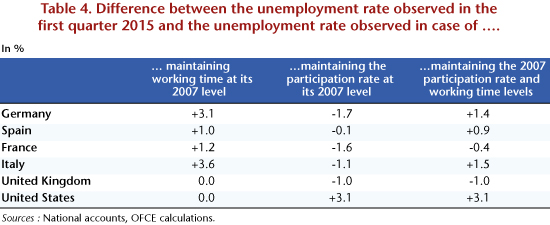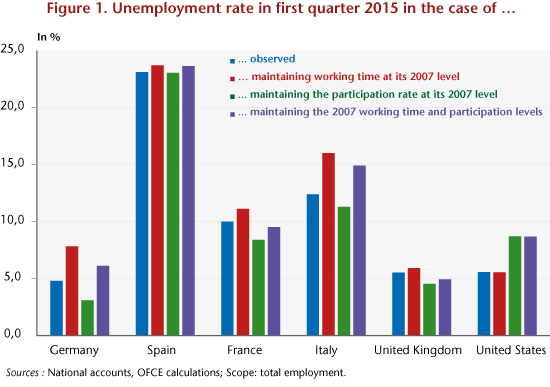By Bruno Ducoudré and Pierre Madec
Considering the euro zone on the one hand and the United States and the United Kingdom on the other, changes in unemployment rates are a reflection of the divergences in growth highlighted in our last fiscal year forecast. While between 2008 and late 2010, trends in unemployment reflected the sharp deterioration in growth and did not differ much between the euro zone, the UK and the USA, differences began to emerge from 2011. In the United Kingdom and the United States, unemployment has been falling since 2011, whereas, after a brief respite, a second phase of rising rates took place in most euro zone countries (Table 1). It was only more recently that the unemployment rate has really begun to fall in Europe (late 2013 in Spain and early 2015 in France and Italy). Overall, for the period 2011-2015 the rate rose overall (+2.7 points) in Spain. In Italy, this deterioration in the labour market even worsened (+4.5 points in this period, against +2.2 points from early 2007 to late 2010). France, though to a lesser extent, was not spared.
An analysis of the unemployment rate does not however convey the full dynamics at work in the labour market (Tables 2 and 3), in particular in terms of underemployment. Thus during the crisis most European countries reduced the effective working time [1] to a greater or lesser degree, through policies on partial unemployment, the reduction of overtime, or the use of working-time accounts, but also through the expansion of part-time work (especially in Italy and Spain), including on an involuntary basis. Conversely, the favourable trend in the US labour market is partly due to a significant decline in the participation rate, which stood in the first quarter of 2015 at 62.8%, 3.3 points lower than eight years ago.
In order to measure the impact of these adjustments (working time and participation rate) on unemployment, it is possible, subject to a number of assumptions [2], to calculate the unemployment rate at constant employment and control for these adjustments. Except for the United States, where the participation rate has fallen sharply since 2007, all the countries studied experienced an increase in their labour force (employed + unemployed) that was greater than in the general population; in many countries this was due to pension reforms. Mechanically, in the absence of job creation, the impact of this demographic trend is to push up the unemployment rate in the countries concerned. For instance, if the participation rate had remained at its 2007 level, the unemployment rate would be lower by 1.6 points in France and 1.1 points in Italy (Table 4). Conversely, without the significant contraction in the US labour force, the unemployment rate would have been more than 3 points higher than what was seen in 2015. Also note that since the crisis Germany has experienced a significant drop in unemployment (-4.2 points) even though its participation rate grew by 2.2 points. Assuming an unchanged participation rate, Germany’s unemployment rate would be 3.1% (Figure 1).
In terms of working time, the lessons seem quite different. It thus appears that if working time had been maintained in all the countries at its pre-crisis level, the unemployment rate would have been more than 3 points higher in Germany and Italy and about 1 point higher in France and Spain, countries in which working time decreased sharply only from 2011. In the US and UK, the situation is very different: working time has changed only very little since the crisis. By controlling for working time, the unemployment rate thus changes along the lines observed in the two countries.
The tendency for working time to fall is a familiar story. Since the late 1990s, all the countries studied have greatly reduced their working hours. In Germany, between 1998 and 2008, the reduction was on average 0.6% per quarter. In France, the transition to the 35-hour week caused a similar reduction over the period. In Italy, the United Kingdom and the United States, the downward shifts in average working hours were respectively -0.3%, -0.4% and -0.3% per quarter. In total, between 1998 and 2008, working time fell by 6% in Germany and France, 4% in Italy, 3% in the United Kingdom and the United States and 2% in Spain, which was de facto the only country that during the crisis intensified the decline in working time that started in the late 1990s.
[1] Working time is understood here as the total number of hours worked by employees and the self-employed (i.e. total employment).
[2] It is assumed that, at constant use, a one-point increase in the participation rate leads to an increase in the unemployment rate. Employment and working time are not considered here in full-time equivalents. Finally, neither the “halo of unemployment” nor any possible “bending effects” are taken into account.





Leave a Reply